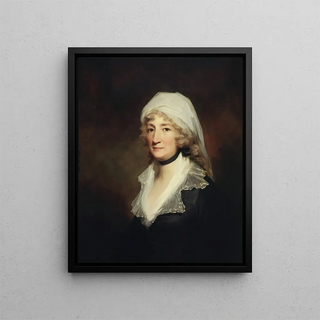Art print | Lady Anne Miller de Glenlee - Sir Henry Raeburn


View from behind

Frame (optional)
Lady Anne Miller de Glenlee - Sir Henry Raeburn – Captivating Introduction
In the fascinating world of 18th-century British painting, the art print "Lady Anne Miller de Glenlee" by Sir Henry Raeburn stands out for its timeless beauty and refined elegance. This portrait, which captures the very essence of its subject, evokes an atmosphere of nobility and grace. Lady Anne, dressed in a delicate gown, seems to rise above the conventions of her era, offering a penetrating gaze that transcends the simple frame of the portrait. This artwork, through its realistic approach and harmonious composition, invites the viewer to delve into the intimacy of aristocratic life, while revealing the subtleties of a period marked by social and cultural changes.
Style and uniqueness of the work
The uniqueness of "Lady Anne Miller de Glenlee" lies in Raeburn's technical mastery, which manages to combine realism and idealization. The delicate features of Lady Anne are rendered with remarkable precision, each detail of her face and attire demonstrating meticulous attention. The color palette, subtle and nuanced, plays a vital role in creating the atmosphere of the painting. Shadows and lights, skillfully manipulated, confer depth and dimension to the work, allowing Lady Anne's figure to stand out from the background while harmoniously integrating into it. The posture of her body, slightly tilted, as well as the gentle smile brushing her lips, suggest a personality that is both strong and approachable, making the portrait all the more captivating.
The artist and his influence
Sir Henry Raeburn, an emblematic figure of Scottish painting, left an indelible mark on art history. Active in Edinburgh, he captured the spirit of his time through his portraits, which combine realism and sensitivity. Raeburn is distinguished by his ability to portray not only the physical appearance of his subjects but also their character and essence. His work has influenced many artists, both in Scotland and beyond, advocating a humanist and empathetic approach to portraiture. By choosing to depict figures from Scottish high society, he

Matte finish

View from behind

Frame (optional)
Lady Anne Miller de Glenlee - Sir Henry Raeburn – Captivating Introduction
In the fascinating world of 18th-century British painting, the art print "Lady Anne Miller de Glenlee" by Sir Henry Raeburn stands out for its timeless beauty and refined elegance. This portrait, which captures the very essence of its subject, evokes an atmosphere of nobility and grace. Lady Anne, dressed in a delicate gown, seems to rise above the conventions of her era, offering a penetrating gaze that transcends the simple frame of the portrait. This artwork, through its realistic approach and harmonious composition, invites the viewer to delve into the intimacy of aristocratic life, while revealing the subtleties of a period marked by social and cultural changes.
Style and uniqueness of the work
The uniqueness of "Lady Anne Miller de Glenlee" lies in Raeburn's technical mastery, which manages to combine realism and idealization. The delicate features of Lady Anne are rendered with remarkable precision, each detail of her face and attire demonstrating meticulous attention. The color palette, subtle and nuanced, plays a vital role in creating the atmosphere of the painting. Shadows and lights, skillfully manipulated, confer depth and dimension to the work, allowing Lady Anne's figure to stand out from the background while harmoniously integrating into it. The posture of her body, slightly tilted, as well as the gentle smile brushing her lips, suggest a personality that is both strong and approachable, making the portrait all the more captivating.
The artist and his influence
Sir Henry Raeburn, an emblematic figure of Scottish painting, left an indelible mark on art history. Active in Edinburgh, he captured the spirit of his time through his portraits, which combine realism and sensitivity. Raeburn is distinguished by his ability to portray not only the physical appearance of his subjects but also their character and essence. His work has influenced many artists, both in Scotland and beyond, advocating a humanist and empathetic approach to portraiture. By choosing to depict figures from Scottish high society, he






